#Customer Reviews Data Scraping Scrape Customer Reviews Data Extract Customer Reviews Data
Explore tagged Tumblr posts
Text
Google Search Results Data Scraping
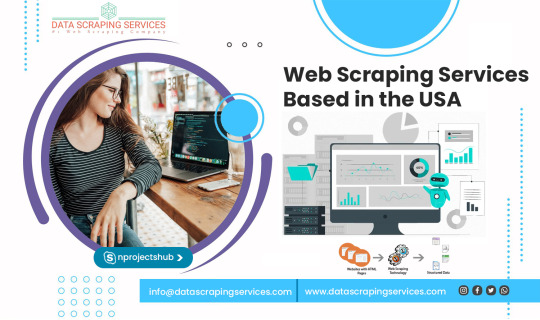
Google Search Results Data Scraping
Harness the Power of Information with Google Search Results Data Scraping Services by DataScrapingServices.com. In the digital age, information is king. For businesses, researchers, and marketing professionals, the ability to access and analyze data from Google search results can be a game-changer. However, manually sifting through search results to gather relevant data is not only time-consuming but also inefficient. DataScrapingServices.com offers cutting-edge Google Search Results Data Scraping services, enabling you to efficiently extract valuable information and transform it into actionable insights.
The vast amount of information available through Google search results can provide invaluable insights into market trends, competitor activities, customer behavior, and more. Whether you need data for SEO analysis, market research, or competitive intelligence, DataScrapingServices.com offers comprehensive data scraping services tailored to meet your specific needs. Our advanced scraping technology ensures you get accurate and up-to-date data, helping you stay ahead in your industry.
List of Data Fields
Our Google Search Results Data Scraping services can extract a wide range of data fields, ensuring you have all the information you need:
-Business Name: The name of the business or entity featured in the search result.
- URL: The web address of the search result.
- Website: The primary website of the business or entity.
- Phone Number: Contact phone number of the business.
- Email Address: Contact email address of the business.
- Physical Address: The street address, city, state, and ZIP code of the business.
- Business Hours: Business operating hours
- Ratings and Reviews: Customer ratings and reviews for the business.
- Google Maps Link: Link to the business’s location on Google Maps.
- Social Media Profiles: LinkedIn, Twitter, Facebook
These data fields provide a comprehensive overview of the information available from Google search results, enabling businesses to gain valuable insights and make informed decisions.
Benefits of Google Search Results Data Scraping
1. Enhanced SEO Strategy
Understanding how your website ranks for specific keywords and phrases is crucial for effective SEO. Our data scraping services provide detailed insights into your current rankings, allowing you to identify opportunities for optimization and stay ahead of your competitors.
2. Competitive Analysis
Track your competitors’ online presence and strategies by analyzing their rankings, backlinks, and domain authority. This information helps you understand their strengths and weaknesses, enabling you to adjust your strategies accordingly.
3. Market Research
Access to comprehensive search result data allows you to identify trends, preferences, and behavior patterns in your target market. This information is invaluable for product development, marketing campaigns, and business strategy planning.
4. Content Development
By analyzing top-performing content in search results, you can gain insights into what types of content resonate with your audience. This helps you create more effective and engaging content that drives traffic and conversions.
5. Efficiency and Accuracy
Our automated scraping services ensure you get accurate and up-to-date data quickly, saving you time and resources.
Best Google Data Scraping Services
Scraping Google Business Reviews
Extract Restaurant Data From Google Maps
Google My Business Data Scraping
Google Shopping Products Scraping
Google News Extraction Services
Scrape Data From Google Maps
Google News Headline Extraction
Google Maps Data Scraping Services
Google Map Businesses Data Scraping
Google Business Reviews Extraction
Best Google Search Results Data Scraping Services in USA
Dallas, Portland, Los Angeles, Virginia Beach, Fort Wichita, Nashville, Long Beach, Raleigh, Boston, Austin, San Antonio, Philadelphia, Indianapolis, Orlando, San Diego, Houston, Worth, Jacksonville, New Orleans, Columbus, Kansas City, Sacramento, San Francisco, Omaha, Honolulu, Washington, Colorado, Chicago, Arlington, Denver, El Paso, Miami, Louisville, Albuquerque, Tulsa, Springs, Bakersfield, Milwaukee, Memphis, Oklahoma City, Atlanta, Seattle, Las Vegas, San Jose, Tucson and New York.
Conclusion
In today’s data-driven world, having access to detailed and accurate information from Google search results can give your business a significant edge. DataScrapingServices.com offers professional Google Search Results Data Scraping services designed to meet your unique needs. Whether you’re looking to enhance your SEO strategy, conduct market research, or gain competitive intelligence, our services provide the comprehensive data you need to succeed. Contact us at [email protected] today to learn how our data scraping solutions can transform your business strategy and drive growth.
Website: Datascrapingservices.com
Email: [email protected]
#Google Search Results Data Scraping#Harness the Power of Information with Google Search Results Data Scraping Services by DataScrapingServices.com. In the digital age#information is king. For businesses#researchers#and marketing professionals#the ability to access and analyze data from Google search results can be a game-changer. However#manually sifting through search results to gather relevant data is not only time-consuming but also inefficient. DataScrapingServices.com o#enabling you to efficiently extract valuable information and transform it into actionable insights.#The vast amount of information available through Google search results can provide invaluable insights into market trends#competitor activities#customer behavior#and more. Whether you need data for SEO analysis#market research#or competitive intelligence#DataScrapingServices.com offers comprehensive data scraping services tailored to meet your specific needs. Our advanced scraping technology#helping you stay ahead in your industry.#List of Data Fields#Our Google Search Results Data Scraping services can extract a wide range of data fields#ensuring you have all the information you need:#-Business Name: The name of the business or entity featured in the search result.#- URL: The web address of the search result.#- Website: The primary website of the business or entity.#- Phone Number: Contact phone number of the business.#- Email Address: Contact email address of the business.#- Physical Address: The street address#city#state#and ZIP code of the business.#- Business Hours: Business operating hours#- Ratings and Reviews: Customer ratings and reviews for the business.
0 notes
Text
Enhance Decision-Making with OpenTable Reviews Data Scraping
How to Enhance Decision-Making With OpenTable Reviews Data Scraping Service?
Introduction
In the restaurant industry, customer feedback is a valuable resource for making informed decisions. Platforms like OpenTable provide extensive reviews from diners, offering insights into customer preferences, satisfaction levels, and areas for improvement. However, manually analyzing this data can be time-consuming and inefficient. This is where an OpenTable Restaurant Reviews Data Scraping Service becomes indispensable. By leveraging automated data collection tools, businesses can gain actionable insights to enhance decision-making, improve customer experience, and stay ahead in the competitive restaurant industry.
Understanding the Importance of OpenTable Reviews
OpenTable is one of the leading platforms for restaurant reservations, offering a rich repository of customer feedback through reviews. These reviews provide a glimpse into customer satisfaction, food quality, ambiance, and service. Utilizing an OpenTable Reviews Data Scraping Service allows businesses to:
Identify Trends: Discover patterns in customer preferences, popular dishes, or common complaints.
Monitor Competitors: Gain insights into what competitors are doing well and where they’re falling short.
Enhance Customer Experience: Use feedback to tailor services, menus, and ambiance to customer needs.
Drive Data-Driven Decisions: Base decisions on reliable data rather than assumptions or limited samples.
How to Scrape OpenTable Reviews Data Effectively
To extract valuable insights, businesses need a robust strategy for Scrape OpenTable Reviews Data. Here are the key steps:
1. Define Your Objectives
Before starting, identify your goals. Are you looking to analyze overall customer satisfaction, compare your restaurant with competitors, or track specific KPIs like service speed or menu variety? Defining objectives will streamline the scraping process.
2. Choose the Right Tools
Several OpenTable Reviews Data Web Scraping Tools are available to simplify the extraction process. Look for tools that:
Handle large datasets efficiently.
Provide APIs for seamless integration.
Offer customization options to target specific data points like ratings, comments, or timestamps.
3. Implement APIs for Seamless Access
Using an OpenTable Website Reviews Data Scraping API can make the process more efficient. APIs allow businesses to extract data programmatically, ensuring accuracy and saving time.
4. Ensure Compliance
When engaging in OpenTable Restaurant reviews data scraping, it’s crucial to adhere to ethical and legal guidelines. Always review the platform’s terms of service to avoid potential violations.
5. Clean and Organize Data
Raw data often requires cleaning to remove duplicates, incomplete entries, or irrelevant information. Organizing the data into structured formats like CSV or JSON ensures easy analysis.
Applications of OpenTable Reviews Data Scraping Service
1. Customer Sentiment Analysis
Analyzing customer sentiments from reviews helps businesses understand how diners perceive their restaurants. Tools for Extract OpenTable Reservation Reviews Data provide insights into recurring themes like food quality, ambiance, or service efficiency.
2. Competitive Benchmarking
By performing Web Scraping OpenTable Reviews Data for competitors, businesses can identify areas where they excel or lag. This benchmarking helps in setting realistic goals and refining strategies.
3. Menu Optimization
Using OpenTable Restaurant Menu Reviews Data Extraction, restaurants can identify which dishes resonate most with customers. Similarly, feedback on less popular items can guide menu adjustments.
4. Marketing Strategy Development
Insights from OpenTable App Reviews Data Collection can inform marketing campaigns. For instance, positive reviews highlighting unique dishes or exceptional service can be used as testimonials in advertisements.
5. Operational Improvements
Feedback on slow service, crowded seating, or unclean environments can be addressed promptly. The data extracted via Restaurant Reviews Data Scraping Service ensures that no critical issue goes unnoticed.
Benefits of Using OpenTable Reviews Data Scraping Service
1. Automation
Automated tools reduce the time and effort required to collect and analyze data. Businesses can focus on strategic actions rather than manual data gathering.
2. Scalability
An OpenTable Reviews Data Scraping Service can handle extensive datasets, enabling businesses to analyze reviews from multiple locations or competitors simultaneously.
3. Accuracy
Advanced scraping tools ensure high accuracy, extracting only relevant and error-free data. This reliability is crucial for making informed decisions.
4. Real-Time Insights
With tools like an OpenTable Website Reviews Data Scraping API, businesses can access real-time data, staying updated on customer feedback and market trends.
5. Cost-Effectiveness
Investing in a professional Restaurant Reviews Data Scraping Service is more economical than hiring a dedicated team for manual data collection and analysis.
Overcoming Challenges in OpenTable Reviews Data Scraping Service
While scraping OpenTable reviews offers significant benefits, it’s not without challenges. Here are common issues and how to address them:
1. CAPTCHA and Bot Detection
Many websites, including OpenTable, implement CAPTCHA and other bot detection mechanisms. Using advanced tools with CAPTCHA-solving capabilities ensures uninterrupted data extraction.
2. Dynamic Content
Dynamic websites often load reviews through JavaScript, making scraping more complex. Employing tools designed for JavaScript-heavy sites can overcome this challenge.
3. Data Volume
Handling large datasets can be resource-intensive. Opting for scalable solutions ensures efficiency in OpenTable Reviews Data Web Scraping Tools.
4. Legal Compliance
To avoid legal issues, ensure that your scraping activities comply with OpenTable’s terms of service and relevant data protection laws.
Future Trends in OpenTable Reviews Data Scraping Service
1. AI-Powered Analysis
Integrating AI with OpenTable Reviews Data Web Scraping Tools enables deeper insights through natural language processing and sentiment analysis.
2. Predictive Analytics
Using scraped data to predict customer behavior, seasonal trends, or emerging preferences will become a key focus.
3. Integration with CRM Systems
Seamless integration of scraped data with customer relationship management (CRM) systems will help businesses personalize customer experiences.
Conclusion
An OpenTable Reviews Data Scraping Service is an invaluable tool for restaurants aiming to make data-driven decisions. By leveraging insights from Scrape OpenTable Reviews Data, businesses can enhance customer experiences, refine their operations, and gain a competitive edge. With the right tools and strategies, the possibilities are endless.
For businesses seeking reliable solutions, Datazivot offers comprehensive services tailored to your needs. Contact us today to unlock the full potential of OpenTable Reviews Data Scraping Service and transform your decision-making process!
Source : https://www.datazivot.com/open-table-reviews-data-scraping-service.php
2 notes
·
View notes
Text
Why Should You Do Web Scraping for python

Web scraping is a valuable skill for Python developers, offering numerous benefits and applications. Here’s why you should consider learning and using web scraping with Python:
1. Automate Data Collection
Web scraping allows you to automate the tedious task of manually collecting data from websites. This can save significant time and effort when dealing with large amounts of data.
2. Gain Access to Real-World Data
Most real-world data exists on websites, often in formats that are not readily available for analysis (e.g., displayed in tables or charts). Web scraping helps extract this data for use in projects like:
Data analysis
Machine learning models
Business intelligence
3. Competitive Edge in Business
Businesses often need to gather insights about:
Competitor pricing
Market trends
Customer reviews Web scraping can help automate these tasks, providing timely and actionable insights.
4. Versatility and Scalability
Python’s ecosystem offers a range of tools and libraries that make web scraping highly adaptable:
BeautifulSoup: For simple HTML parsing.
Scrapy: For building scalable scraping solutions.
Selenium: For handling dynamic, JavaScript-rendered content. This versatility allows you to scrape a wide variety of websites, from static pages to complex web applications.
5. Academic and Research Applications
Researchers can use web scraping to gather datasets from online sources, such as:
Social media platforms
News websites
Scientific publications
This facilitates research in areas like sentiment analysis, trend tracking, and bibliometric studies.
6. Enhance Your Python Skills
Learning web scraping deepens your understanding of Python and related concepts:
HTML and web structures
Data cleaning and processing
API integration
Error handling and debugging
These skills are transferable to other domains, such as data engineering and backend development.
7. Open Opportunities in Data Science
Many data science and machine learning projects require datasets that are not readily available in public repositories. Web scraping empowers you to create custom datasets tailored to specific problems.
8. Real-World Problem Solving
Web scraping enables you to solve real-world problems, such as:
Aggregating product prices for an e-commerce platform.
Monitoring stock market data in real-time.
Collecting job postings to analyze industry demand.
9. Low Barrier to Entry
Python's libraries make web scraping relatively easy to learn. Even beginners can quickly build effective scrapers, making it an excellent entry point into programming or data science.
10. Cost-Effective Data Gathering
Instead of purchasing expensive data services, web scraping allows you to gather the exact data you need at little to no cost, apart from the time and computational resources.
11. Creative Use Cases
Web scraping supports creative projects like:
Building a news aggregator.
Monitoring trends on social media.
Creating a chatbot with up-to-date information.
Caution
While web scraping offers many benefits, it’s essential to use it ethically and responsibly:
Respect websites' terms of service and robots.txt.
Avoid overloading servers with excessive requests.
Ensure compliance with data privacy laws like GDPR or CCPA.
If you'd like guidance on getting started or exploring specific use cases, let me know!
2 notes
·
View notes
Text
How Web Scraping TripAdvisor Reviews Data Boosts Your Business Growth
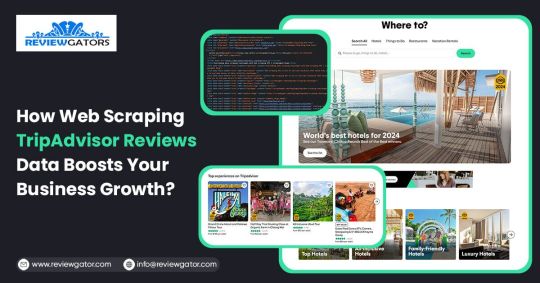
Are you one of the 94% of buyers who rely on online reviews to make the final decision? This means that most people today explore reviews before taking action, whether booking hotels, visiting a place, buying a book, or something else.
We understand the stress of booking the right place, especially when visiting somewhere new. Finding the balance between a perfect spot, services, and budget is challenging. Many of you consider TripAdvisor reviews a go-to solution for closely getting to know the place.
Here comes the accurate game-changing method—scrape TripAdvisor reviews data. But wait, is it legal and ethical? Yes, as long as you respect the website's terms of service, don't overload its servers, and use the data for personal or non-commercial purposes. What? How? Why?
Do not stress. We will help you understand why many hotel, restaurant, and attraction place owners invest in web scraping TripAdvisor reviews or other platform information. This powerful tool empowers you to understand your performance and competitors' strategies, enabling you to make informed business changes. What next?
Let's dive in and give you a complete tour of the process of web scraping TripAdvisor review data!
What Is Scraping TripAdvisor Reviews Data?
Extracting customer reviews and other relevant information from the TripAdvisor platform through different web scraping methods. This process works by accessing publicly available website data and storing it in a structured format to analyze or monitor.
Various methods and tools available in the market have unique features that allow you to extract TripAdvisor hotel review data hassle-free. Here are the different types of data you can scrape from a TripAdvisor review scraper:
Hotels
Ratings
Awards
Location
Pricing
Number of reviews
Review date
Reviewer's Name
Restaurants
Images
You may want other information per your business plan, which can be easily added to your requirements.
What Are The Ways To Scrape TripAdvisor Reviews Data?
TripAdvisor uses different web scraping methods to review data, depending on available resources and expertise. Let us look at them:
Scrape TripAdvisor Reviews Data Using Web Scraping API
An API helps to connect various programs to gather data without revealing the code used to execute the process. The scrape TripAdvisor Reviews is a standard JSON format that does not require technical knowledge, CAPTCHAs, or maintenance.
Now let us look at the complete process:
First, check if you need to install the software on your device or if it's browser-based and does not need anything. Then, download and install the desired software you will be using for restaurant, location, or hotel review scraping. The process is straightforward and user-friendly, ensuring your confidence in using these tools.
Now redirect to the web page you want to scrape data from and copy the URL to paste it into the program.
Make updates in the HTML output per your requirements and the information you want to scrape from TripAdvisor reviews.
Most tools start by extracting different HTML elements, especially the text. You can then select the categories that need to be extracted, such as Inner HTML, href attribute, class attribute, and more.
Export the data in SPSS, Graphpad, or XLSTAT format per your requirements for further analysis.
Scrape TripAdvisor Reviews Using Python
TripAdvisor review information is analyzed to understand the experience of hotels, locations, or restaurants. Now let us help you to scrape TripAdvisor reviews using Python:
Continue reading https://www.reviewgators.com/how-web-scraping-tripadvisor-reviews-data-boosts-your-business-growth.php
#review scraping#Scraping TripAdvisor Reviews#web scraping TripAdvisor reviews#TripAdvisor review scraper
2 notes
·
View notes
Text
Amazon Product Review Data Scraping | Scrape Amazon Product Review Data

In the vast ocean of e-commerce, Amazon stands as an undisputed titan, housing millions of products and catering to the needs of countless consumers worldwide. Amidst this plethora of offerings, product reviews serve as guiding stars, illuminating the path for prospective buyers. Harnessing the insights embedded within these reviews can provide businesses with a competitive edge, offering invaluable market intelligence and consumer sentiment analysis.
In the realm of data acquisition, web scraping emerges as a potent tool, empowering businesses to extract structured data from the labyrinthine expanse of the internet. When it comes to Amazon product review data scraping, this technique becomes particularly indispensable, enabling businesses to glean actionable insights from the vast repository of customer feedback.
Understanding Amazon Product Review Data Scraping
Amazon product review data scraping involves the automated extraction of reviews, ratings, and associated metadata from Amazon product pages. This process typically entails utilizing web scraping tools or custom scripts to navigate through product listings, access review sections, and extract relevant information systematically.
The Components of Amazon Product Review Data:
Review Text: The core content of the review, containing valuable insights, opinions, and feedback from customers regarding their experience with the product.
Rating: The numerical or star-based rating provided by the reviewer, offering a quick glimpse into the overall satisfaction level associated with the product.
Reviewer Information: Details such as the reviewer's username, profile information, and sometimes demographic data, which can be leveraged for segmentation and profiling purposes.
Review Date: The timestamp indicating when the review was posted, aiding in trend analysis and temporal assessment of product performance.
The Benefits of Amazon Product Review Data Scraping
1. Market Research and Competitive Analysis:
By systematically scraping Amazon product reviews, businesses can gain profound insights into market trends, consumer preferences, and competitor performance. Analyzing the sentiment expressed in reviews can unveil strengths, weaknesses, opportunities, and threats within the market landscape, guiding strategic decision-making processes.
2. Product Enhancement and Innovation:
Customer feedback serves as a treasure trove of suggestions and improvement opportunities. By aggregating and analyzing product reviews at scale, businesses can identify recurring themes, pain points, and feature requests, thus informing product enhancement strategies and fostering innovation.
3. Reputation Management:
Proactively monitoring and addressing customer feedback on Amazon can be instrumental in maintaining a positive brand image. Through sentiment analysis and sentiment-based alerts derived from scraped reviews, businesses can swiftly identify and mitigate potential reputation risks, thereby safeguarding brand equity.
4. Pricing and Promotion Strategies:
Analyzing Amazon product reviews can provide valuable insights into perceived product value, price sensitivity, and the effectiveness of promotional campaigns. By correlating review sentiments with pricing fluctuations and promotional activities, businesses can refine their pricing strategies and promotional tactics for optimal market positioning.
Ethical Considerations and Best Practices
While Amazon product review data scraping offers immense potential, it's crucial to approach it ethically and responsibly. Adhering to Amazon's terms of service and respecting user privacy are paramount. Businesses should also exercise caution to ensure compliance with relevant data protection regulations, such as the GDPR.
Moreover, the use of scraped data should be guided by principles of transparency and accountability. Clearly communicating data collection practices and obtaining consent whenever necessary fosters trust and credibility.
Conclusion
Amazon product review data scraping unlocks a wealth of opportunities for businesses seeking to gain a competitive edge in the dynamic e-commerce landscape. By harnessing the power of automated data extraction and analysis, businesses can unearth actionable insights, drive informed decision-making, and cultivate stronger relationships with their customers. However, it's imperative to approach data scraping with integrity, prioritizing ethical considerations and compliance with regulatory frameworks. Embraced judiciously, Amazon product review data scraping can be a catalyst for innovation, growth, and sustainable business success in the digital age.
3 notes
·
View notes
Text
Tapping into Fresh Insights: Kroger Grocery Data Scraping
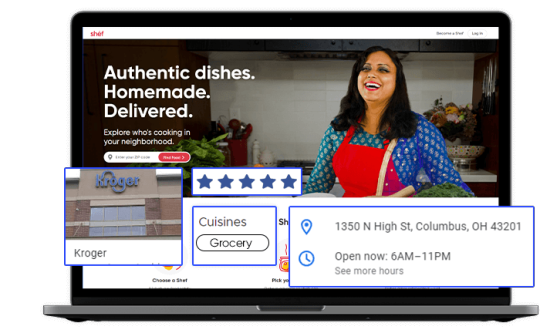
In today's data-driven world, the retail grocery industry is no exception when it comes to leveraging data for strategic decision-making. Kroger, one of the largest supermarket chains in the United States, offers a wealth of valuable data related to grocery products, pricing, customer preferences, and more. Extracting and harnessing this data through Kroger grocery data scraping can provide businesses and individuals with a competitive edge and valuable insights. This article explores the significance of grocery data extraction from Kroger, its benefits, and the methodologies involved.
The Power of Kroger Grocery Data
Kroger's extensive presence in the grocery market, both online and in physical stores, positions it as a significant source of data in the industry. This data is invaluable for a variety of stakeholders:
Kroger: The company can gain insights into customer buying patterns, product popularity, inventory management, and pricing strategies. This information empowers Kroger to optimize its product offerings and enhance the shopping experience.
Grocery Brands: Food manufacturers and brands can use Kroger's data to track product performance, assess market trends, and make informed decisions about product development and marketing strategies.
Consumers: Shoppers can benefit from Kroger's data by accessing information on product availability, pricing, and customer reviews, aiding in making informed purchasing decisions.
Benefits of Grocery Data Extraction from Kroger
Market Understanding: Extracted grocery data provides a deep understanding of the grocery retail market. Businesses can identify trends, competition, and areas for growth or diversification.
Product Optimization: Kroger and other retailers can optimize their product offerings by analyzing customer preferences, demand patterns, and pricing strategies. This data helps enhance inventory management and product selection.
Pricing Strategies: Monitoring pricing data from Kroger allows businesses to adjust their pricing strategies in response to market dynamics and competitor moves.
Inventory Management: Kroger grocery data extraction aids in managing inventory effectively, reducing waste, and improving supply chain operations.
Methodologies for Grocery Data Extraction from Kroger
To extract grocery data from Kroger, individuals and businesses can follow these methodologies:
Authorization: Ensure compliance with Kroger's terms of service and legal regulations. Authorization may be required for data extraction activities, and respecting privacy and copyright laws is essential.
Data Sources: Identify the specific data sources you wish to extract. Kroger's data encompasses product listings, pricing, customer reviews, and more.
Web Scraping Tools: Utilize web scraping tools, libraries, or custom scripts to extract data from Kroger's website. Common tools include Python libraries like BeautifulSoup and Scrapy.
Data Cleansing: Cleanse and structure the scraped data to make it usable for analysis. This may involve removing HTML tags, formatting data, and handling missing or inconsistent information.
Data Storage: Determine where and how to store the scraped data. Options include databases, spreadsheets, or cloud-based storage.
Data Analysis: Leverage data analysis tools and techniques to derive actionable insights from the scraped data. Visualization tools can help present findings effectively.
Ethical and Legal Compliance: Scrutinize ethical and legal considerations, including data privacy and copyright. Engage in responsible data extraction that aligns with ethical standards and regulations.
Scraping Frequency: Exercise caution regarding the frequency of scraping activities to prevent overloading Kroger's servers or causing disruptions.
Conclusion
Kroger grocery data scraping opens the door to fresh insights for businesses, brands, and consumers in the grocery retail industry. By harnessing Kroger's data, retailers can optimize their product offerings and pricing strategies, while consumers can make more informed shopping decisions. However, it is crucial to prioritize ethical and legal considerations, including compliance with Kroger's terms of service and data privacy regulations. In the dynamic landscape of grocery retail, data is the key to unlocking opportunities and staying competitive. Grocery data extraction from Kroger promises to deliver fresh perspectives and strategic advantages in this ever-evolving industry.
#grocerydatascraping#restaurant data scraping#food data scraping services#food data scraping#fooddatascrapingservices#zomato api#web scraping services#grocerydatascrapingapi#restaurantdataextraction
4 notes
·
View notes
Text
Travel Data Intelligence - Extract Travel, Hotel and Flights Price Data
Travel Data Intelligence – Extract Travel, Hotel and Flights Price Data
Utilize Travel Data Intelligence for Hotel, Flight, and Travel Price Insights and Elevate Your Journey!
Online Travel Industry
In today's rapidly evolving online travel industry, competition is fiercer than ever. One of the challenges businesses across various sectors, such as airlines, rail services, car rental agencies, hotels, and travel companies, face is the constant price fluctuation in their offerings. Staying on top of these price changes is crucial to maximize revenue and remain competitive in this dynamic market. The ability to efficiently track and adapt to these fluctuations can make a significant difference in the success of businesses in these sectors.
However, access to real-time data is essential to stay ahead in the fiercely competitive online travel industry. It is where web scraping for travel data emerges as the perfect solution. Many hotel, travel, and airline businesses seek professional assistance from specialized hotel, travel, and airline data scraping services to ensure accuracy and efficiency. These services provide valuable data insights that empower businesses to make informed decisions and maintain their competitive edge.
Pick A Tour Type
Flight & Airline
Car Rental
Hotel & OTAs
Vacation Rental
Travel Intelligence Solution
Data Extraction
Travel Data Extraction
Scrape hotel, travel & flight data to provide a strategic advantage to Online Travel Agencies (OTAs), car rental agencies, airlines, and rail companies by furnishing them with valuable insights to optimize pricing strategies, enhance customer experiences, and gain a competitive edge in the dynamic travel industry.
Our Travel Intelligence services empower businesses in the travel and hospitality sector with comprehensive data analysis and insights. It allows them to make data-driven decisions, optimize pricing, improve customer service, and better understand market trends. Whether you're an Online Travel Agency (OTA), a hotel, a car rental agency, or an airline, Travel Data Scrape can provide the essential tools to thrive in a highly competitive and rapidly evolving industry.
Business Insights
Travel Business Insights (Dashboard)
Travel Business Insights offers a comprehensive and interactive perspective on the reports generated through travel data extraction. These dashboard insights allow businesses in the travel industry to gain a deeper understanding of their operations, market trends, and customer behavior. By leveraging the data extraction process, businesses can access valuable information and statistics that can be pivotal in making informed decisions, optimizing services, and enhancing customer experiences.
Online Travel Intelligence Process
Data Collection
Data Cleaning
Data Analysis
Insight Generation
Decision Implementation
Airlines Data Extraction
Comprehensive Data Collection: Our airline data Extraction service gathers a wide range of data, including flight schedules, pricing, seat availability, and passenger reviews, providing airlines with a holistic view of their operations.
Competitive Analysis: Airlines can use this data to conduct in-depth competitive analysis, comparing their pricing and services against competitors to stay competitive and make data-driven decisions.
Demand Forecasting: Airlines can predict future demand patterns by analyzing historical data, enabling better capacity planning and optimized pricing strategies.
Price Monitoring: Real-time price monitoring helps airlines stay agile in a rapidly changing market, adjusting fares in response to market conditions and customer demand.
Customer Insights: Passenger reviews and feedback data allow airlines to understand customer preferences and pain points, leading to improved customer service and experience.
Enhanced Revenue Generation: With access to accurate and up-to-date data, airlines can make informed decisions that enhance revenue generation, streamline operations, and ultimately improve their overall performance in the industry.
Cruise and Ferry Data Extraction
Strategic Pricing: Cruise and ferry operators can utilize extracted data to implement dynamic pricing strategies, adjusting ticket fares based on demand, occupancy, and competitive pricing, thereby maximizing revenue.
Route Optimization: Cruise and Ferry data extraction enables companies to analyze historical travel patterns and passenger preferences, optimizing routes to provide the most attractive and efficient itineraries.
Competitive Intelligence: By monitoring competitors' pricing and offerings, cruise and ferry companies can gain valuable insights into market dynamics, allowing them to remain competitive and adapt their services accordingly.
Customer Experience Enhancement: Extracted passenger reviews and feedback data provide essential insights for improving onboard amenities, services, and overall customer satisfaction, fostering loyalty and positive reviews.
Operational Efficiency: Access to cabin availability and occupancy rates data allows operators to manage resources more effectively, ensuring efficient use of onboard facilities.
Market Expansion: With a deep understanding of market trends and traveler preferences, cruise and ferry companies can identify opportunities for expansion, new routes, and target demographics, facilitating business growth.
Car Rental Data Extraction
Optimize Pricing Strategies: Car rental companies can use the extracted data to adjust pricing dynamically, considering factors like demand, seasonal variations, and competitor pricing, resulting in increased revenue.
Route Planning: Access to historical data allows for better route planning, optimizing schedules and stops to cater to passenger needs and streamline operations.
Competitor Analysis: By monitoring competitors' pricing and services, car rental sector businesses can gain valuable insights into market trends and customer preferences, staying competitive and making data-driven decisions.
Fleet Management: Real-time data on car availability and occupancy rates helps car rental agencies manage their fleets efficiently, ensuring vehicle usage to its full potential.
Customer Satisfaction: Passenger reviews and feedback data provide essential insights for enhancing customer service and overall passenger satisfaction, which can lead to improved customer loyalty and positive reviews.
Expansion Opportunities: A deep understanding of market dynamics and traveler behavior allows businesses to identify opportunities for expanding services to new locations and target demographics, ultimately fostering business growth.
Hotel Data Scraping
Pricing and Availability: Extract data on room rates, availability, and special offers from the hotel's website or online booking platforms for hotels to stay competitive in their pricing strategies.
Guest Reviews and Ratings: Collecting guest reviews and ratings from websites of online travel agencies to gauge customer satisfaction and identify areas for improvement.
Competitor Analysis: Gathering data on nearby hotels, including their pricing, occupancy rates, and amenities, to benchmark against the competition and adjust strategies accordingly.
Online Reputation Management: Monitoring online mentions of the hotel across social media, blogs, and review sites to manage the hotel's reputation and respond to customer feedback.
Customer Demographics: Extracting data on guest demographics, including their age, nationality, and booking preferences, can tailor marketing and services to the specific needs and preferences of different customer segments.
Occupancy and Revenue Forecasting: Collect historical occupancy and revenue data to make predictions and optimize pricing, staffing, and marketing strategies for future bookings.
OTAS and Metas
Comprehensive Price Comparison: Scraping OTAs and Metasearch sites allows travelers to compare prices from various sources in one place, enabling them to find the best deals quickly and easily.
Time and Cost Savings: By automating the process of gathering travel information, users can save time and find cost-effective travel options they might have missed through manual searches.
Real-time Updates: Scraping provides access to real-time data on pricing and availability, ensuring that travelers receive the most up-to-date information and can take advantage of time-sensitive promotions.
Customization and Alerts: Configure scraping tools to send notifications when desired travel deals or promotions become available, making it easier for travelers to stay informed and act swiftly.
Hidden Discounts: OTAs and Metasearch engines may offer unadvertised exclusive deals or discounts. Scraping helps uncover these hidden gems, allowing travelers to access unique savings.
Market Insights: Scraped data helps businesses in the travel industry to gain insights into market trends, competitive pricing strategies, and customer preferences, facilitating informed decision-making and strategy development.
Vacation Rentals
Broad Search Capability: Vacation rental scraping tools can search multiple websites, aggregating a wide range of rental listings from different sources, giving users access to a more comprehensive selection.
Time and Cost Efficiency: It saves users time and effort by automating finding vacation rentals, allowing them to compare options and prices more efficiently.
Real-Time Availability: Users can access real-time information on the availability and pricing of vacation rentals, ensuring they secure the most up-to-date and accurate information.
Price Comparison: Scraping tools enable users to compare prices for similar vacation rentals across different platforms, helping them find the best deals and potentially saving money.
Customization and Alerts: Users can set up alerts for specific criteria or price changes to inform price drops or new listings that match their preferences.
Informed Decision Making: By collecting and presenting data on various vacation rental options, scraping tools empower travelers to make informed decisions about where to stay based on location, price, amenities, and user reviews.
Package Providers
Cost Savings: Scraping enables users to compare prices and packages from multiple travel providers, helping them find the most affordable travel packages that suit their budget and preferences.
Comprehensive Information: Users can access detailed information about travel packages, including itineraries, inclusions, and terms and conditions, allowing them to make informed decisions.
Customization Opportunities: Scraped data can highlight package components, enabling travelers to customize their trips by selecting specific accommodations, activities, or add-ons that match their preferences.
Real-time Updates: Users can receive real-time package availability and pricing updates, ensuring they take advantage of limited-time promotions or deals.
Streamlined Booking: Scraping simplifies the booking process by consolidating travel package information in one place, reducing the time and effort required to book a complete vacation.
User Reviews and Ratings: Access to reviews and ratings for travel packages and providers allows users to make informed decisions based on the experiences of previous travelers, increasing confidence in their choices.
#TravelDataIntelligence#ExtractTravelHotelandFlightsPriceData#webscrapingfortraveldata#hoteltravelandairlinedatascrapingservices
1 note
·
View note
Text
Leverage Web Scraping Product Data from Jumia Website
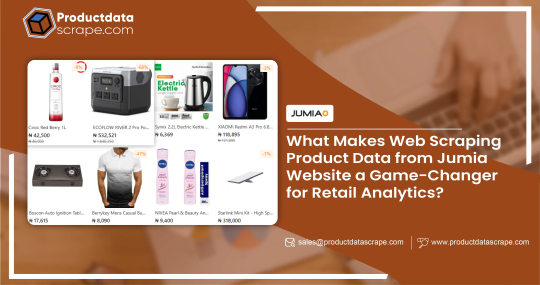
Introduction
In the ever-evolving world of online retail, businesses and data enthusiasts constantly seek accurate, real-time, and structured data to understand market trends, competitor strategies, and consumer behavior. Africa's e-commerce landscape is thriving, and among its leading players, Jumia has emerged as a dominant force. As a digital marketplace that connects millions of customers and thousands of sellers, Jumia hosts a vast and dynamic product catalog that makes it a goldmine of data for analysis and innovation. Web Scraping Product Data from the Jumia Website has become a strategic method to collect this treasure trove of retail insights efficiently and systematically.
An Overview of the Jumia Website and Its Product Categories
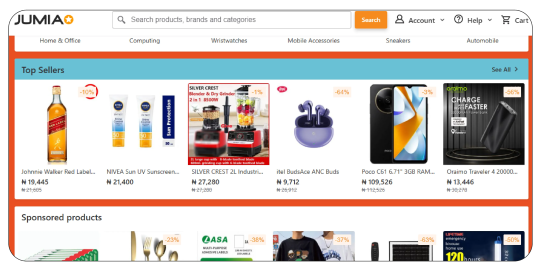
Jumia, often dubbed the "Amazon of Africa," operates across more than 10 African countries, including Nigeria, Kenya, Egypt, and Morocco. It is Africa's premier online shopping platform and offers a wide array of products and services across categories such as:
Electronics: Smartphones, laptops, tablets, televisions, accessories, and gadgets from global and local brands. These products cater to both budget-conscious consumers and premium buyers, supporting digital lifestyles across age groups.
Fashion: Clothing, shoes, and accessories for men, women, and children, catering to diverse styles and budgets. Trend-focused inventory helps brands keep pace with seasonal demands and regional preferences.
Home and Living: Furniture, kitchen appliances, home décor, and cleaning products that enhance comfort and functionality. These items support modern and traditional households with both aesthetic and practical solutions.
Health and Beauty: Cosmetics, skincare, supplements, and personal care essentials. These products address wellness needs and beauty routines, and are often tailored to specific demographics and skin types.
Groceries and Essentials: Food, beverages, household supplies, and baby products forming part of daily needs. These items are crucial for high-frequency purchases and repeat consumer engagement.
Automotive and Industrial Tools: Car accessories, machinery, and equipment for both consumers and small businesses. This category supports repair, maintenance, and industrial operations across sectors.
With thousands of product listings constantly updated with prices, discounts, seller ratings, reviews, and availability, Jumia presents a rich dataset for any analyst or developer aiming to Extract Jumia Product Data for various use cases.
Why Scraping Jumia Product Data Matters?
The dynamic nature of Jumia's inventory and pricing structures makes it difficult to monitor manually. Data scraping allows for the automated collection of this information, enabling businesses to make informed decisions based on live data rather than outdated assumptions. Whether tracking the latest smartphone launches or monitoring price fluctuations of daily-use items, scraping Jumia's data empowers decision-makers with actionable insights.
When organizations Scrape Jumia Product Listings Data, they are better equipped to:
Identify top-selling products and trending brands: Analyze marketplace data to determine which items are leading in sales and which brands are gaining popularity. This helps in optimizing product listings and curating high-demand inventories.
Understand competitor pricing strategies: Track how competitors price their products across categories to stay competitive. Use this data to adjust pricing dynamically and identify opportunities for promotional offers.
Monitor user reviews for customer sentiment: Analyze product feedback to assess satisfaction levels, identify common issues, and improve offerings based on real consumer experiences.
Track inventory levels and stock availability: Keep an eye on stock status and replenishment cycles to avoid out-of-stock situations. This helps maintain sales continuity and improves customer trust.
Evaluate seller performance and delivery efficiency: Measure delivery timelines, order accuracy, and seller ratings to ensure optimal service levels. Identify gaps and improve logistics or seller partnerships where needed.
This data can be harvested without direct integrations or costly manual labor, making it a high-return investment for growing businesses.
Key Purposes of Scraping Product Data from Jumia
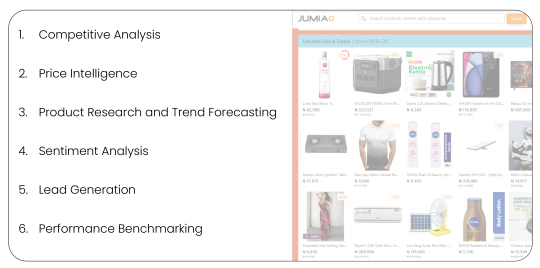
Scraping e-commerce platforms like Jumia serves various business, technology, and research purposes. Some of the most prevalent objectives include:
1. Competitive Analysis: Compare your brand or products with similar offerings listed on Jumia to understand their market position.
2. Price Intelligence: Automate tracking product pricing changes to remain competitive in real-time.
3. Product Research and Trend Forecasting: Analyze which product categories are gaining momentum in specific regions.
4. Sentiment Analysis: Extract customer reviews and ratings for natural language processing to understand user sentiment.
5. Lead Generation: Identify high-performing sellers and potential distribution partners.
6. Performance Benchmarking: Evaluate service delivery and user satisfaction indicators.
In a digital economy where data-driven strategies yield better outcomes, Real-Time Jumia Product Data Scraping has become crucial for maintaining agility in a fast-paced marketplace.
Applications and Benefits of Scraped Jumia Product Data
Scraping product data from Jumia is not just about data collection—it's about transforming that data into strategic value. Here are some key ways businesses and researchers benefit from scraped datasets:
Market Entry Planning: Startups planning to launch products in African markets can use Jumia data to assess demand and competition.
Retail Intelligence Dashboards: Build interactive dashboards that update in real-time to track Jumia's product performance, customer behavior, and category trends.
Price Comparison Engines: Create tools that allow users to compare prices across different platforms, helping them make informed purchasing decisions.
Dynamic Pricing Models: Use scraped data to develop machine learning models that optimize pricing for online stores.
Demand Forecasting: Analyze past sales data trends (via stock status, reviews, etc.) to predict future demand more accurately.
Using a Jumia E-commerce Product Data Scraper, data can be organized, analyzed, and visualized across various business intelligence tools. Whether a marketing team seeks customer insights or a procurement team looks to optimize supply chains, the applications are diverse and impactful.
The Role of APIs and Automation in Scraping Jumia Data

While scraping data using scripts and crawlers is common, integrating automation through APIs allows for more structured and scalable data pipelines. A Web Scraping API for Jumia Products can be configured to extract specific data points like product title, price, seller name, stock level, customer rating, discount percentage, and more. These APIs enable real-time synchronization with Jumia's ever-changing product catalog, eliminating the need for manual refreshes or outdated datasets.
This approach is especially beneficial for businesses with large-scale data needs, such as online aggregators, logistics players, or digital marketing firms that rely on timely and accurate product data.
Unlock powerful retail insights today with our advanced data scraping solutions—start extracting value from Jumia now!
The Significance of Price and Inventory Datasets
One of the most valuable datasets that businesses focus on is pricing. With thousands of product SKUs on Jumia, price volatility can be monitored and leveraged. Companies Scrape the Jumia Product Price Dataset to study pricing algorithms, understand promotional patterns, and adjust their product offerings accordingly.
Another significant metric is stock availability. Tracking product availability helps supply chain planning and estimating demand for seasonal products, gadgets, or consumables. In a broader scope, when organizations Extract E-commerce Data from platforms like Jumia, they gain access to deep insights previously obscured by the vastness of digital catalogs.
The Future of E-Commerce Scraping: Jumia's Growing Role
As digital adoption in Africa continues to grow, the scope of e-commerce platforms like Jumia is expected to expand even further. The continent is experiencing a rapid increase in internet penetration, mobile usage, and digital payments. Jumia can leverage this momentum by broadening its product base, increasing seller participation, and offering hyper-local services.
Consequently, the need for Web Scraping E-commerce Websites like Jumia will grow exponentially. To remain competitive in African markets, businesses will demand more granular, real-time, and region-specific data. Data scraping will no longer be a nice-to-have tool; it will be an essential engine for data-driven decisions.
Advanced technologies like AI, machine learning, and big data analytics will increasingly rely on structured, scraped datasets from platforms like Jumia. Furthermore, Ecommerce Data Scraping Services are evolving to offer customized, real-time, high-frequency scraping options that make e-commerce analytics possible and predictive.
As data infrastructure improves across the African continent, the quality, quantity, and strategic value of the insights gathered from scraping will also increase.
The Importance of Comprehensive E-Commerce Datasets

Access to a well-structured Ecommerce Product Price Dataset allows retailers, researchers, and policymakers to study pricing anomalies, regional economic patterns, and market demands. Combining data from Jumia with other datasets unlocks macro-level insights into Africa's growing digital economy.
In addition to raw pricing data, scraped metadata—such as review frequency, brand popularity, or delivery timelines—provides nuanced context for every decision. This makes it easier for businesses to optimize campaigns, fine-tune their listings, and cater to customer needs in real-time.
How Product Data Scrape Can Help You?
Boosts Market Research Efficiency: Gather detailed product and pricing data to accelerate competitor analysis and consumer trend identification.
Enhances Decision-Making: Access accurate, real-time datasets to support smarter pricing, inventory planning, and product launch strategies.
Supports Business Intelligence Tools: Seamlessly integrate scraped data into BI platforms to generate actionable insights and performance dashboards.
Saves Time and Resources: Eliminate manual data collection efforts through automated scraping workflows customized to your business goals.
Enables Predictive Analytics: Use historical and real-time data to forecast demand patterns, optimize operations, and stay ahead of market shifts.
Final Thoughts
In conclusion, Jumia represents more than just a digital storefront—it is a reflection of Africa's thriving and evolving consumer landscape. For businesses aiming to succeed in this market, harnessing the power of data is non-negotiable. Extract Popular E-Commerce Website Data like Jumia to decode consumer behavior, evaluate product trends, and build intelligent, responsive strategies.
Whether you're a data scientist, a marketer, an entrepreneur, or an analyst, leveraging Web Scraping Product Data from Jumia Website opens the doors to unprecedented market understanding. As competition grows fiercer and the digital space becomes increasingly crowded, access to accurate, real-time data will be the difference between leading and lagging. By embedding data scraping into their core strategy, modern businesses are not just reacting to the market but shaping it.
At Product Data Scrape, we strongly emphasize ethical practices across all our services, including Competitor Price Monitoring and Mobile App Data Scraping. Our commitment to transparency and integrity is at the heart of everything we do. With a global presence and a focus on personalized solutions, we aim to exceed client expectations and drive success in data analytics. Our dedication to ethical principles ensures that our operations are both responsible and effective.
Source >>>https://www.productdatascrape.com/web-scraping-jumia-product-data-retail-analytics.php
#WebScrapingProductDataFromJumiaWebsite#ScrapeJumiaProductListingsData#RealTimeJumiaProductDataScraping#JumiaEcommerceProductDataScraper#WebScrapingAPIForJumiaProducts#ExtractEcommerceData
0 notes
Text
Why Travel Scraping is Crucial for OTA Companies in 2025
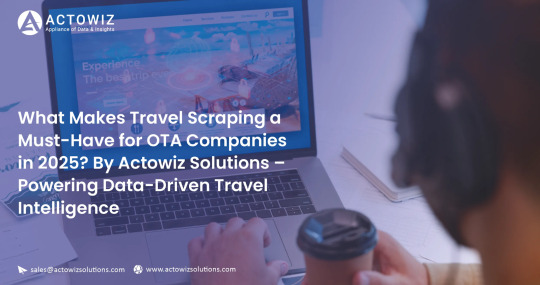
Introduction
Online Travel Agencies (OTAs) are facing intense pressure in 2025 to deliver real-time pricing, instant availability, and hyper-personalized offers. With platforms like Booking.com, Expedia, Agoda, MakeMyTrip, Airbnb, and Skyscanner evolving rapidly, the need for competitive intelligence and dynamic content tracking has never been more critical.
Travel scraping—the extraction of structured travel data from various OTA, airline, and hotel platforms—has become a strategic weapon. With Actowiz Solutions, travel aggregators, pricing engines, and marketplace platforms are harnessing scraping to outpace competitors and meet traveler expectations in real time.
Why Travel Scraping Is Essential in 2025
1. Dynamic Pricing Dominates
Airlines and hotels change prices hourly—sometimes minute-by-minute.
85% of flights and hotel rates experience at least one pricing shift per day (Source: Actowiz Travel Data, 2025).
Travel scraping allows OTAs to:
Capture price drops instantly
Align or beat competitor prices
Alert users in real time
2. Inventory Shifts Are Constant
Hotel availability and airline seat inventory fluctuate based on:
Events/festivals
Weather patterns
Cancellation surges
Actowiz scraping pipelines detect:
Room category changes
Seat class stockouts
Last-minute opening of premium rooms
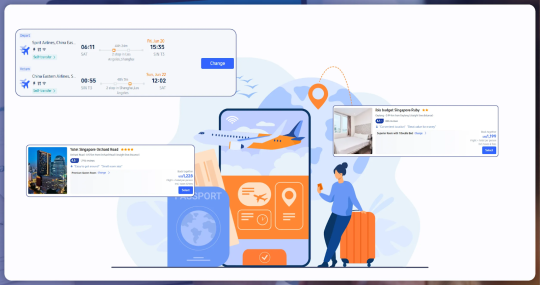
What Travel Data Can Be Scraped?
Flight Pricing:
Platforms Tracked: Skyscanner, Kayak, Google Flights
Value Delivered: Dynamic airfare monitoring
Hotel Rates:
Platforms Tracked: Booking.com, Agoda, Airbnb, Expedia
Value Delivered: Price comparison & availability
Car Rentals:
Platforms Tracked: Hertz, Avis, Zoomcar, Turo
Value Delivered: Local rental pricing trends
Reviews & Ratings:
Platforms Tracked: TripAdvisor, Google Travel, OTA reviews
Value Delivered: Sentiment tracking & customer feedback
Vacation Packages:
Platforms Tracked: MMT, Yatra, Priceline
Value Delivered: Promotion benchmarking
City Taxes/Fees:
Platforms Tracked: Regional travel portals
Value Delivered: Accurate final price display
Sample Data: Hotel Room Rate Changes (Mumbai, June 2025)
June 5:
Hotel: The Taj Palace
OTA: Booking.com
Room Type: Deluxe Suite
Price: ₹18,200
Availability: Available
June 6:
Hotel: The Taj Palace
OTA: Agoda
Room Type: Deluxe Suite
Price: ₹17,550
Availability: Low Stock
June 7:
Hotel: The Taj Palace
OTA: MMT (MakeMyTrip)
Room Type: Deluxe Suite
Price: ₹19,000
Availability: Sold Out
Insight:
OTAs using Actowiz scraping can automatically adjust markups, suggest alternates, or promote similar listings.
Competitive Edge from Travel Scraping
🏷️ Dynamic Price Matching
Actowiz enables auto-repricing for airlines or hotels listed across multiple platforms.
Detect when a competitor undercuts your offer and adjust in real time.
📆 Smart Availability Monitoring
Room inventory or flight seats running low?
Actowiz triggers price hikes or urgency messages on your OTA interface.
⭐ Sentiment & Review Analysis
Track real-time guest reviews across platforms
Identify top-rated amenities per city or hotel
Integrate feedback trends into listings
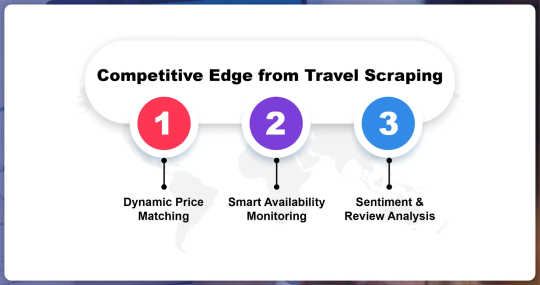
Visual Insight: Average Flight Fare Trends (New York to Dubai, June 2025)
![Flight Price Trend Placeholder Chart]
June 1:
Platform: Expedia
Avg Fare: $620
June 3:
Platform: Kayak
Avg Fare: $645
June 5:
Platform: Skyscanner
Avg Fare: $599
Actowiz’s scraping dashboards allow real-time fare visualization and anomaly detection.
Actowiz Travel Scraping Architecture
✅ High-volume crawling of OTAs, airline, and hotel platforms
✅ Anti-bot bypass (captcha solving, rotating IPs, mobile headers)
✅ Multi-country support across 70+ travel platforms
✅ Delivery via API, CSV, or dashboard
✅ Geo-tagged metadata (city, hotel zone, flight route)
Use Case: OTA Price Benchmarking in Real-Time
Challenge:
An Indian OTA was losing bookings due to inconsistent pricing on global hotel listings.
Solution:
Actowiz monitored 100,000+ hotel prices across Booking.com, Expedia, and Agoda daily.
Detected discrepancies and automated realignment of hotel rates via dynamic feed.
Results:
23% increase in completed bookings
17% reduction in bounce rate due to price mismatch
Review Tracking Sample: Dubai Hotels (June 2025)
Atlantis Dubai:
OTA: TripAdvisor
Review Count: 12,350
Avg Rating: 4.8
Top Keywords: "aqua park", "view"
JW Marriott:
OTA: Booking.com
Review Count: 8,790
Avg Rating: 4.5
Top Keywords: "breakfast", "staff"
Burj Al Arab:
OTA: Expedia
Review Count: 15,410
Avg Rating: 4.9
Top Keywords: "luxury", "spa"
Actowiz NLP Engine summarizes reviews for OTA content and email campaign personalization.
Monitoring Flash Sales and Deals
Capture limited-time deals (Black Friday, Eid, Summer Sales)
Scrape promo banners and hidden offers
Compare bundled travel packages
Actowiz alerting system notifies your pricing team within minutes of new sales going live across any global platform.
Benefits for OTA Teams
📊 Marketing
Run competitor deal-matching campaigns
Build demand-based newsletters using scraped insights
Geo-target ads based on travel trend shifts
🤖 Technology
Integrate live pricing APIs
Feed scraped content into booking engines
Enhance hotel listing accuracy
💼 Business Development
Track inventory of hotel/airline partners
Identify underperforming listings
Benchmark third-party inventory vs direct pricing
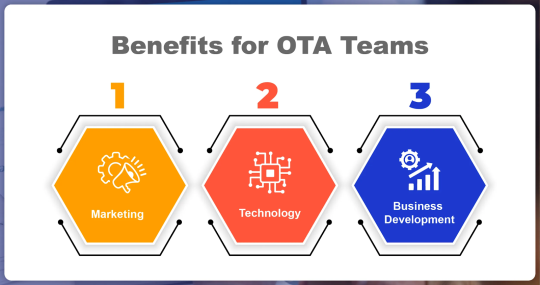
Regional Examples: Country-Wise OTA Scraping Priorities
USA:
Key Platforms: Expedia, Priceline
Use Cases: Airline fare monitoring, hotel bundles
India:
Key Platforms: MakeMyTrip, Yatra
Use Cases: Holiday package optimization
UAE:
Key Platforms: Booking, Trip.com, Agoda
Use Cases: Dynamic hotel inventory, Arab festival demand
UK:
Key Platforms: Kayak, LastMinute
Use Cases: Flash sales tracking
Singapore:
Key Platforms: Agoda, Airbnb
Use Cases: Tourist traffic forecasting via inventory data
Future-Forward Travel Intelligence
In 2025 and beyond, scraping isn’t just a support tool—it’s a core engine that feeds OTA personalization, dynamic pricing, and UX enhancements.
Actowiz Solutions is pioneering this with:
Airline route intelligence
Hotel price forecasting models
Vacation search keyword tracking
Local travel event calendars for prediction models
Final Thoughts
The travel industry is evolving at breakneck speed. OTAs that don’t operate with real-time, scraped insights risk being left behind.
Actowiz Solutions delivers travel scraping as a service—empowering your OTA with flight, hotel, and rental pricing at scale, sentiment tracking, and market-wide availability scanning.
Learn More >>
0 notes
Text
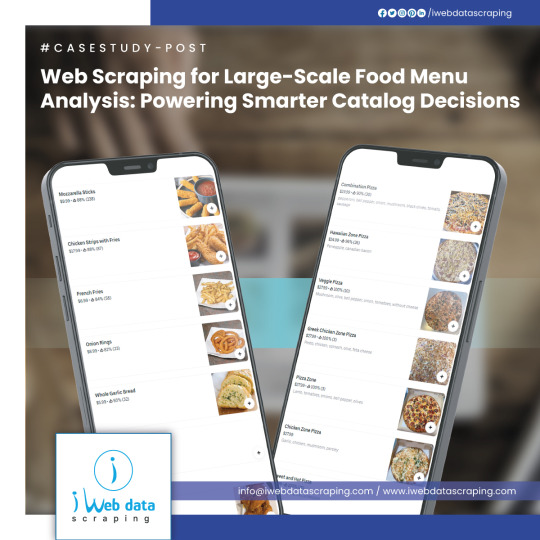
🍽️ #WebScraping for Large-Scale #FoodMenu Analysis: Powering Smarter Catalog Decisions 📊📲
As the food delivery and #RestaurantTechIndustry accelerates, businesses need actionable insights-not just from customer reviews but from the menus themselves. By leveraging large-scale #WebScrapingOfRestaurant menus, foodtech platforms, aggregators, and cloud kitchens can transform scattered data into strategic decisions.
🔍 What Can You Achieve with Menu Data Extraction?
✅ Benchmarking menu pricing and portion trends across regions
✅ Identifying top-selling dishes and cuisine popularity by city or zone
✅ Mapping dietary preferences, allergens, and labeling trends
✅ Enhancing product catalogs and recommendation engines
✅ Optimizing virtual brand launches and ghost kitchen menus
✅ Monitoring seasonal promotions and pricing adjustments
💡 “Menu scraping isn't just data collection—it's decoding what your market is hungry for.”
Whether you're a delivery platform, #RestaurantChain, or F&B strategist, real-time menu intelligence fuels better pricing, smarter catalog planning, and a competitive edge.
🔗 Explore the full solution:
0 notes
Text
✈️ Turn Travel Trends into Business Strategy with Hotel & Flight Data Scraping
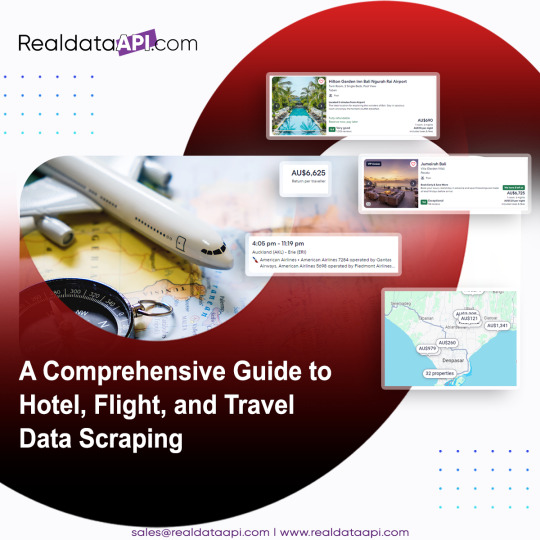
In the highly competitive world of travel and hospitality, real-time data is the game-changer. With RealDataAPI’s Hotel, Flight & Travel Data Scraping services, you can extract granular insights from top booking platforms to power pricing intelligence, route analysis, market trends, and customer behavior tracking.
🔍 What You Can Extract:
● Hotel listings with prices, amenities, star ratings & reviews ● Real-time flight prices, airline schedules & seat availability ● Location-based travel demand trends & occupancy rates ● Customer sentiment from hotel/flight reviews ● Structured JSON/CSV outputs for BI dashboards, CRMs & travel platforms
📊 Whether you're a travel aggregator, airline analyst, OTA, or tourism board—our travel scraping solutions help you forecast demand, optimize pricing, and boost traveler satisfaction.
📩 Contact us: [email protected]
0 notes
Text
Enhance Decision-Making with OpenTable Reviews Data Scraping
Learn how OpenTable Reviews Data Scraping Service helps businesses extract actionable insights for better decision-making, customer experience, and growth in USA, UAE, Australia, and more.
#black tumblr#branding#founder#startup#artists on tumblr#opentablereviewsdatascraping#Extract Open Table Reviews Data#scrapeopentablereviewsdata
1 note
·
View note
Text
Automating Restaurant Menu Data Extraction Using Web Scraping APIs
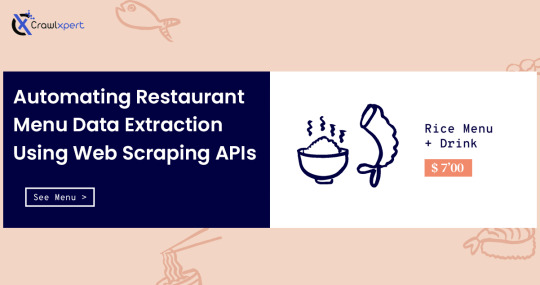
Introduction
The food and restaurant business sector is going very heavily digital with millions of restaurant menus being made available through online platforms. Companies that are into food delivery, restaurant aggregation, and market research require menu data on a real-time basis for competition analysis, pricing strategies, and enhancement of customer experience. Manually collecting and updating this information is time-consuming and a laborious endeavor. This is where web scraping APIs come into play with the automated collection of such information to scrape restaurant menu data efficiently and accurately.
This guide discusses the importance of extracting restaurant menu data, how web scraping works for this use case, some challenges to expect, the best practices in dealing with such issues, and the future direction of menu data automation.
Why Export Restaurant Menu Data?
1. Food Delivery Service
Most online food delivery services, like Uber Eats, DoorDash, and Grubhub, need real-time menu updates for accurate pricing or availability. With the extraction of restaurant menu data, at least those online platforms are kept updated and discrepancies avoidable.
2. Competitive Pricing Strategy
Restaurants and food chains make use of web scraping restaurant menu data to determine their competitors' price positions. By tracking rival menus, they will know how they should price their products to remain competitive in the marketplace.
3. Nutritional and Dietary Insights
Health and wellness platforms utilize menu data for dietary recommendations to customers. By scraping restaurant menu data, these platforms can classify foods according to calorie levels, ingredients, and allergens.
4. Market Research and Trend Analysis
This is the group of data analysts and research firms collecting restaurant menu data to analyze consumer behavior about cuisines and track price variations with time.
5. Personalized Food Recommendations
Machine learning and artificial intelligence now provide food apps with the means to recommend meals according to user preferences. With restaurant menu data web scraping, food apps can access updated menus and thus afford personalized suggestions on food.
How Web Scraping APIs Automate Restaurant Menu Data Extraction
1. Identifying Target Websites
The first step is selecting restaurant platforms such as:
Food delivery aggregators (Uber Eats, DoorDash, Grubhub)
Restaurant chains' official websites (McDonald's, Subway, Starbucks)
Review sites (Yelp, TripAdvisor)
Local restaurant directories
2. Sending HTTP Requests
Scraping APIs send HTTP requests to restaurant websites to retrieve HTML content containing menu information.
3. Parsing HTML Data
The extracted HTML is parsed using tools like BeautifulSoup, Scrapy, or Selenium to locate menu items, prices, descriptions, and images.
4. Structuring and Storing Data
Once extracted, the data is formatted into JSON, CSV, or databases for easy integration with applications.
5. Automating Data Updates
APIs can be scheduled to run periodically, ensuring restaurant menus are always up to date.
Data Fields Extracted from Restaurant Menus
1. Restaurant Information
Restaurant Name
Address & Location
Contact Details
Cuisine Type
Ratings & Reviews
2. Menu Items
Dish Name
Description
Category (e.g., Appetizers, Main Course, Desserts)
Ingredients
Nutritional Information
3. Pricing and Discounts
Item Price
Combo Offers
Special Discounts
Delivery Fees
4. Availability & Ordering Information
Available Timings
In-Stock/Out-of-Stock Status
Delivery & Pickup Options
Challenges in Restaurant Menu Data Extraction
1. Frequent Menu Updates
Restaurants frequently update their menus, making it challenging to maintain up-to-date data.
2. Anti-Scraping Mechanisms
Many restaurant websites implement CAPTCHAs, bot detection, and IP blocking to prevent automated data extraction.
3. Dynamic Content Loading
Most restaurant platforms use JavaScript to load menu data dynamically, requiring headless browsers like Selenium or Puppeteer for scraping.
4. Data Standardization Issues
Different restaurants structure their menu data in various formats, making it difficult to standardize extracted information.
5. Legal and Ethical Considerations
Extracting restaurant menu data must comply with legal guidelines, including robots.txt policies and data privacy laws.
Best Practices for Scraping Restaurant Menu Data
1. Use API-Based Scraping
Leveraging dedicated web scraping APIs ensures more efficient and reliable data extraction without worrying about website restrictions.
2. Rotate IP Addresses & Use Proxies
Avoid IP bans by using rotating proxies or VPNs to simulate different users accessing the website.
3. Implement Headless Browsers
For JavaScript-heavy pages, headless browsers like Puppeteer or Selenium can load and extract dynamic content.
4. Use AI for Data Cleaning
Machine learning algorithms help clean and normalize menu data, making it structured and consistent across different sources.
5. Schedule Automated Scraping Jobs
To maintain up-to-date menu data, set up scheduled scraping jobs that run daily or weekly.
Popular Web Scraping APIs for Restaurant Menu Data Extraction
1. Scrapy Cloud API
A powerful cloud-based API that allows automated menu data scraping at scale.
2. Apify Restaurant Scraper
Apify provides pre-built restaurant scrapers that can extract menu details from multiple platforms.
3. Octoparse
A no-code scraping tool with API integration, ideal for businesses that require frequent menu updates.
4. ParseHub
A flexible API that extracts structured restaurant menu data with minimal coding requirements.
5. CrawlXpert API
A robust and scalable solution tailored for web scraping restaurant menu data, offering real-time data extraction with advanced anti-blocking mechanisms.
Future of Restaurant Menu Data Extraction
1. AI-Powered Menu Scraping
Artificial intelligence will improve data extraction accuracy, enabling automatic menu updates without manual intervention.
2. Real-Time Menu Synchronization
Restaurants will integrate web scraping APIs to sync menu data instantly across platforms.
3. Predictive Pricing Analysis
Machine learning models will analyze scraped menu data to predict price fluctuations and customer demand trends.
4. Enhanced Personalization in Food Apps
By leveraging scraped menu data, food delivery apps will provide more personalized recommendations based on user preferences.
5. Blockchain for Menu Authentication
Blockchain technology may be used to verify menu authenticity, preventing fraudulent modifications in restaurant listings.
Conclusion
Automating the extraction of restaurant menus from the web through scraping APIs has changed the food industry by offering real-time prices, recommendations for food based on liking, and analysis of competitors. With advances in technology, more AI-driven scraping solutions will further improve the accuracy and speed of data collection.
Know More : https://www.crawlxpert.com/blog/restaurant-menu-data-extraction-using-web-scraping-apis
#RestaurantMenuDataExtraction#ScrapingRestaurantMenuData#ExtractRestaurantMenus#ScrapeRestaurantMenuData
0 notes
Text
Use Amazon Review Scraping Services To Boost The Pricing Strategies
Use data extraction services to gather detailed insights from customer reviews. Our advanced web scraping services provide a comprehensive analysis of product feedback, ratings, and comments. Make informed decisions, understand market trends, and refine your business strategies with precision. Stay ahead of the competition by utilizing Amazon review scraping services, ensuring your brand remains attuned to customer sentiments and preferences for strategic growth.
2 notes
·
View notes
Text
How Real-Time Amazon Price Scraping Helps Sellers Stay Competitive
Introduction
In the ever-evolving landscape of e-commerce, staying competitive on platforms like Amazon requires more than just great products. Sellers need real-time pricing intelligence to monitor market trends, identify price drops, and optimize their listings. This is where real-time Amazon price scraping becomes a game-changer.
Actowiz Metrics offers robust Amazon price scraping services that provide up-to-the-minute pricing data, helping sellers make informed decisions, stay ahead of competitors, and boost profitability.
What is Amazon Price Scraping?
Amazon price scraping is the automated process of extracting pricing data from Amazon product listings. This includes:
Current price
Original price (discounted vs. list price)
Seller information
Buy box winner
Ratings and reviews
Availability and stock status
Real-time scraping means this data is updated frequently — sometimes hourly — giving sellers a true competitive edge.
Why Real-Time Pricing Matters
Amazon's dynamic pricing algorithm can change product prices multiple times a day based on:
Competitor activity
Stock levels
Seller rankings
Seasonal demand
Sponsored listings
Without real-time visibility, sellers may miss crucial pricing shifts that can:
Push them out of the Buy Box
Make their listings uncompetitive
Reduce conversion rates
Key Benefits of Real-Time Amazon Price Scraping
1. Win the Buy Box More Often
Real-time pricing insights help sellers stay within the competitive range required to win the Buy Box — a critical factor for increased visibility and sales.
2. Monitor Competitor Moves
Track rival sellers’ pricing strategies, discount patterns, and stockouts to proactively adjust your own.
3. Automate Repricing Strategies
Use scraped data to power automated repricing tools or custom rules — update prices as soon as market conditions shift.
4. Identify Seasonal Trends
Spot when prices spike or dip due to seasonal changes, allowing you to prepare inventory and campaigns accordingly.
5. Benchmark Pricing Across Categories
Compare prices across similar SKUs, brands, or categories to find gaps and opportunities.
Use Cases for Amazon Sellers
Private Label Brands: Analyze how competitors in your niche are pricing their products.
Retail Arbitrage Sellers: Find profitable gaps between retail and Amazon listings.
Aggregators/Enterprise Brands: Centralize pricing data from multiple SKUs and regions.
Digital Marketing Teams: Optimize ad campaigns around pricing triggers.
Why Choose Actowiz Metrics?
Hourly and Daily Price Monitoring
Customizable Data Delivery (API, Excel, Dashboard)
Proxy Rotation and Anti-Block Technology
Support for Global Amazon Marketplaces (US, UK, IN, DE, etc.)
Historical Price Tracking and Trend Visualization
Conclusion
If you're selling on Amazon in 2025, real-time pricing data is no longer a luxury — it's a necessity. Actowiz Metrics empowers e-commerce businesses with real-time Amazon price scraping services that help you outsmart competitors, stay in the Buy Box, and make strategic pricing decisions that drive revenue. Learn More
0 notes
Text
Data Extraction Service From Namshi UAE for Fashion Insights

Introduction
In today's rapidly growing e-commerce environment, data has emerged as a key driver of competitive advantage. This is especially true in the fashion industry, where consumer preferences shift quickly, and online platforms like Namshi UAE dominate the Middle East market. Businesses looking to stay ahead increasingly turn to a Data Extraction Service From Namshi UAE to gain valuable, up-to-date insights. With Real-Time Data Extraction from Namshi UAE, companies can track price fluctuations, monitor competitor strategies, and respond swiftly to changing trends. These services empower retailers, analysts, and market researchers with the data to make informed decisions. Whether identifying popular fashion items or optimizing seasonal promotions, access to such detailed datasets can significantly enhance strategic planning. Namshi UAE Data Scraping Solutions deliver structured, scalable access to product information, ensuring that businesses can keep up with the fast-paced demands of the online fashion world and maintain a data-led advantage.
Why Extract Namshi UAE Data?
Namshi has emerged as a leading player in the Middle East's fashion e-commerce landscape, offering a wide range of global and regional brands. Extract Fashion Product Data from Namshi UAE to give businesses valuable insights into market behavior and consumer trends. Access to this data allows companies to stay competitive by tracking pricing, availability, and evolving preferences. By leveraging this data, brands can make informed decisions and optimize their marketing and inventory strategies for the UAE and GCC region.
Product Availability Insights: Monitor real-time stock status to manage inventory and avoid stockouts.
Pricing Trend Analysis: Track dynamic pricing to remain competitive and understand market fluctuations.
Discount Pattern Tracking: Identify promotional cycles and consumer responses to discount campaigns.
Category Performance Data: Evaluate best-selling categories to focus on high-demand product lines.
Consumer Behavior Monitoring: Understand buyer preferences, sizes, colors, and styles in specific demographics.
Seasonal Demand Forecasting: Align product offerings and marketing with seasonal trends across the UAE and GCC.
Rising Demand for E-commerce Data Extraction in UAE
The UAE has rapidly emerged as one of the top destinations for digital commerce in the Middle East. With increasing smartphone penetration and a tech-savvy population, online shopping has become the norm. This boom has triggered a surge in Web Scraping Namshi Fashion & Apparel Data and other similar platforms, reflecting a growing need for structured datasets that businesses can act upon.
Retailers want granular data on fast-selling products, color and size trends, brand popularity, and customer review sentiments. This has increased demand for Namshi Product Data Scraping API , allowing seamless and continuous extraction of structured information across thousands of SKUs. Companies seeking to expand in the GCC market are investing in these services to track their competitors and build stronger, data-driven sales and inventory strategies.
How Does Scraped Data Benefit Businesses?
In the dynamic world of online fashion retail, timing and relevance are everything. The ability to act on accurate, up-to-date information can make the difference between leading the market or falling behind. Using a Namshi Product Data Scraper, businesses can monitor fluctuating prices, identify best-selling products, and detect inventory gaps.
Scraped data helps fashion labels plan their collections based on consumer demand, optimize pricing based on competitors, and improve customer satisfaction by identifying trending preferences. The ability to Extract Fashion & Apparel Data ensures that businesses are never caught off guard by sudden market shifts or customer behavior changes. Moreover, this real-time intelligence supports logistics, dynamic pricing models, and targeted marketing efforts, ultimately improving ROI.Track Real-Time Pricing Shifts: React swiftly to pricing changes across categories, enabling competitive and profitable price adjustments powered by Data Scraping from Ecommerce Websites.Discover Top-Selling Products: Identify which items are trending and performing well, helping plan collections aligned with current demand.Spot Inventory Gaps Quickly: Detect out-of-stock or low-stock items to manage replenishment and avoid missed sales using Namshi UAE Data Scraping Solutions.Optimize Marketing with Consumer Trends: Use buyer behavior patterns and preferences to launch personalized and time-sensitive campaigns.Boost Operations & Logistics: Enhance inventory planning and fulfillment processes with accurate product availability and demand forecasting using Data Scraping from Ecommerce Website.Increase ROI Through Strategic Moves: Leverage actionable intelligence with Namshi UAE Data Scraping Solutions for smarter merchandising, pricing, and campaign timing.
Role of Namshi UAE Data Extraction Service
A robust Namshi UAE Data Extraction Service acts as the bridge between raw data and actionable insight. Such services provide customized, real-time access to product listings, category hierarchies, promotional campaigns, customer ratings, and availability statuses from the Namshi website.
What distinguishes professional Web Scraping for Fashion & Apparel Data services is their ability to deliver clean, ready-to-use datasets that can be directly integrated into analytical tools or dashboards. Whether you're a fashion aggregator, competitor analysis firm, or market research agency, these services help you collect data efficiently and ethically, keeping your operations compliant with local regulations and business standards.
Unlock smarter e-commerce decisions—start your data scraping journey with us today!
How to Choose the Right Service for Your Needs?
Choosing the right data scraping provider is critical to ensuring accuracy, reliability, and compliance. Start by identifying the scope of your project. Are you focusing only on pricing data, or do you also need customer reviews, promotional patterns, and product availability? Understanding your need will help you shortlist the appropriate Ecommerce Data Scraping Services.
Look for providers specializing in Web Scraping E-commerce Websites with a track record of success in the UAE market. Scalability is another important factor; your service should be able to grow with your data needs. Ensure they offer robust APIs like the Namshi Product Data Scraping API, support frequent updates, and can customize output formats (CSV, JSON, Excel) for easy integration with your tools. Finally, consider how the provider handles data integrity, error handling, and website structure changes.
The right service provider will enable you to generate an Ecommerce Product Price Dataset that reflects current market conditions and helps you predict upcoming trends. Whether you are trying to adjust your pricing model or streamline inventory, a powerful scraping tool is indispensable.
How Does Product Data Scrape Help You?
Custom-Built Scrapers for Every Platform: We develop tailored scraping solutions to efficiently extract data from complex and dynamic e-commerce platforms like Amazon, Namshi, and more.
Real-Time Data Accuracy: Our systems ensure the data collected is timely, accurate, and relevant, capturing updates on pricing, availability, discounts, and product changes as they happen.
Scalable Infrastructure: Whether it's scraping hundreds or millions of product listings, our robust architecture can handle large-scale data extraction without performance issues.
Compliance and Data Hygiene: We follow ethical data scraping practices and ensure clean, structured output ready for analysis or integration into your internal tools.
Actionable Insights Delivery: Beyond data, we provide insights and dashboards to help businesses quickly respond to trends, gaps, and competitor strategies in the e-commerce space.
Conclusion
The Middle East's fashion e-commerce scene is evolving rapidly, and Namshi is a central platform that reflects these changes in real time. By investing, businesses can tap into the pulse of consumer demand and stay ahead of their competitors. The power of Data Extraction Service From Namshi UAE lies in gathering large amounts of data and transforming this data into business intelligence.
As more retailers realize the significance of data-driven decisions, real-time data extraction will become essential for survival and growth. From optimizing marketing campaigns to building smarter inventory systems, the benefits are far-reaching. In the high-stakes world of fashion and e-commerce, data is no longer optional—it's a strategic necessity.
At Product Data Scrape, we strongly emphasize ethical practices across all our services, including Competitor Price Monitoring and Mobile App Data Scraping. Our commitment to transparency and integrity is at the heart of everything we do. With a global presence and a focus on personalized solutions, we aim to exceed client expectations and drive success in data analytics. Our dedication to ethical principles ensures that our operations are both responsible and effective.
Source >>https://www.productdatascrape.com/data-extraction-service-namshi-uae-fashion-insights.php
#DataExtractionServiceFromNamshiUAE#RealTimeDataExtractionFromNamshiUAE#ExtractFashionProductDataFromNamshiUAE#WebScrapingNamshiFashionAndApparelData#NamshiProductDataScrapingAPI
0 notes